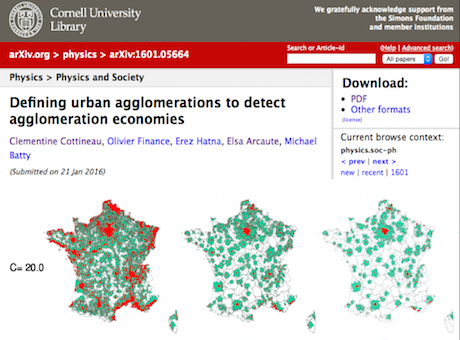Vonu Thakuriah, Nebiyou Tilahun and Moira Zellner organized a very successful conference in August 2014 in Chicago. CASA had two papers at the meeting and you can drill down and find them in the Proceedings which you get access to here. Its a big file of 40MB so it may take time to download. Ollie O’Brien gave a paper on our work with dashboards and Greg Erhardt talked about his work with smart card and digital data pertaining to the use of transit in the San Francisco Bay Area. But there are many other papers in these proceedings which are well worth looking at as they provide a very useful snapshot of the state of the art which is still very much a moving target. The Workshop on Big Data and Urban Informatics was funded by NSF, featuring papers on urban data analysis, management, planning, social equity, sustainability and more.
Big Data and Urban Informatics
Agglomeration, The Keys to the Good City?
In CASA, in a project lead by Clementine Cottineau, we are working how economic and social attributes of cities scale with size. This is one of our longstanding foci in our ERC Mechanicity Work and it will also be central to our new project, the UKRDFC (the UK Regions Digital Research Facility) which will look at how the digital economy in Britain is influencing our cities and regions and their performance. Clementine has just posted an analysis of these issues with respect to regions and cities in France. You can download the paper from the ARXIV and if you read the paper, then it is worth noting that Clementine and the group’s previous papers are useful background. The paper on Paradoxes of Scaling is key to the analysis and these are all in ARXIV – if you click here and then on any of the authors noted there, up will come the paper trail. Enjoy.
China Rising? Empty Cities, Ghost Towns
My current editorial in Environment and Planning B tracks the massive investments in infrastructure in China which have taken place since the Great Recession of 2007-2008. One of the key features of contemporary economic systems is their volatility with respect to the dynamics of property development. Building booms and busts follow major economic cycles and in Britain in the last 50 years there have been at least three if not four such cycles.
But the mother of all booms is that which has pervaded China since 2008 when the government there decided to reflate the economy by providing many with cheap finance to build. And build they did, with little reference to demand, with the boom predicated on the basis that if ‘we build it they will come’. Come they have not and as the boom turns into bust as it is fast appearing to do, its looks very much as though the market for property in China will drive wider markets relating production to consumption, possibly to collapse.
Wayne Shepard’s interesting book Ghost Cities of China (2013) poses the question as to whether or not the construction of so much property, particularly buildings meant for housing, which remain empty and are located in places that seem to have little rationale as good locations will attract populations in time as China continues to urbanise. This is an intriguing question. Our experience in western economies suggests otherwise but in the editorial, I pose the question as to whether the Chinese economy will continue to ignore the laws of financial gravity. I don’t think so but you never can tell. Recent events in the markets also suggest otherwise but with China you never know. An economy that constitutes 20 percent of world demand could well herald a new era when bubbles never burst and when investments never yield. As in most economies, at the end of the day, psychology appears to reign supreme.
There is plenty to read about all this, Robert Peston’s short videos referred to in the editorial make good watching and only this week, there are various comments on China’s economy: see for example the interesting comment in the Guardian Online
Get the editorial by clocking on the picture above or the link here.











